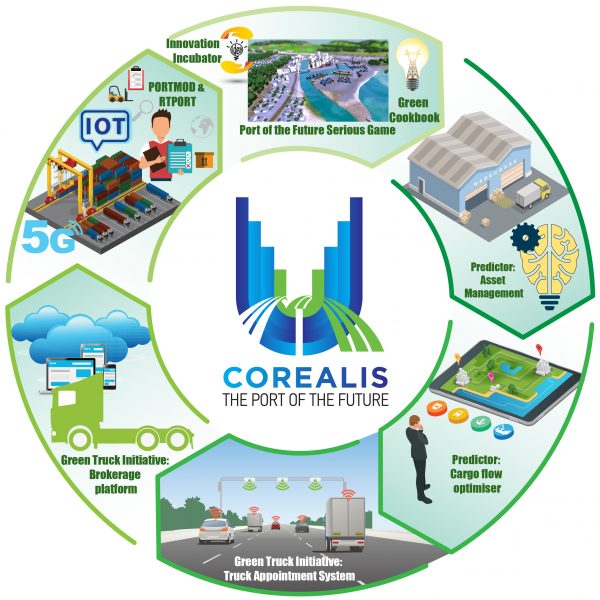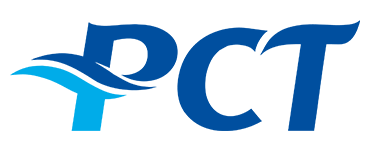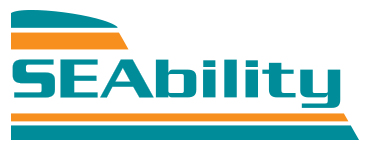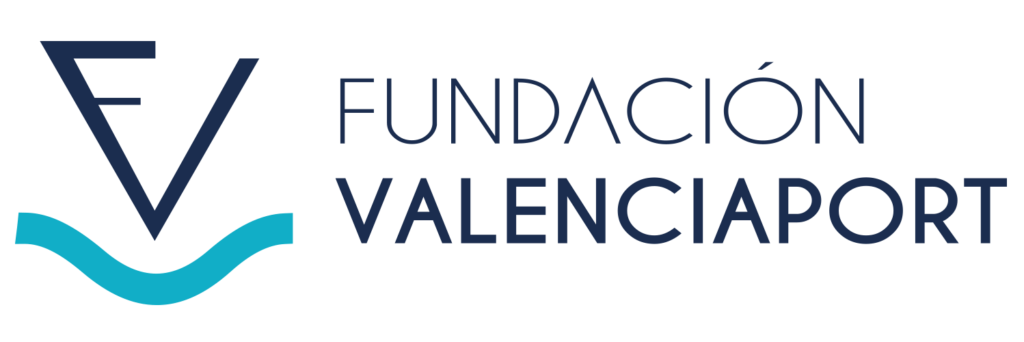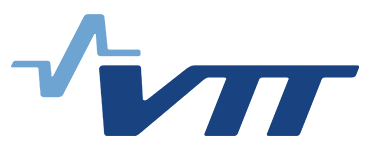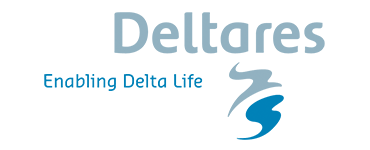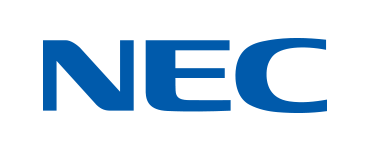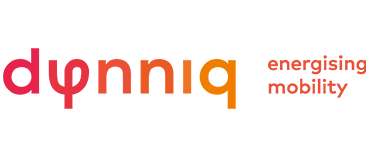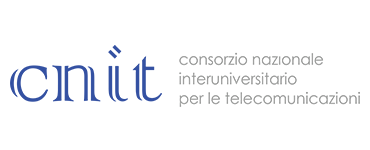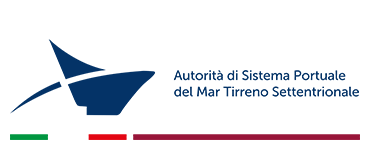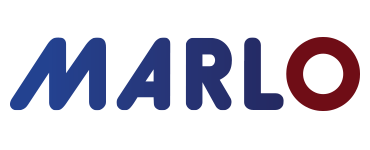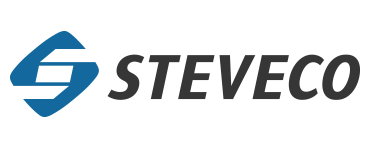The Project
Title: Capacity with a pOsitive enviRonmEntal and societAL footprInt: portS in the future era – COREALIS
Contracting Authority: European Commission H2020
Contract Number: 768994
Start Date: 01/05/2018
End Date: 30/04/2021
EC funding: 5,150,540.00 €
Project Coordinator: Dr. Angelos Amditis, ICCS (A.Amditis@iccs.gr)
COREALIS proposes a strategic, innovative framework, supported by disruptive technologies, including Internet of Things (IoT), data analytics, next generation traffic management and emerging 5G networks, for cargo ports to handle upcoming and future capacity, traffic, efficiency and environmental challenges. The proposed beyond state of the art innovations, target to increase efficiency and optimize land use, while being financially viable, respecting circular economy principles and being of service to the urban environment.
The innovations will be implemented and tested in real operating conditions in 5 Living Labs, namely Piraeus port, Valencia port, Antwerp port, Livorno port and Haminakotka port, and are briefly presented in the figure below:
The Objectives
These port-driven technological and societal innovations are tailored to realize COREALIS high level objectives, which are focused on:
![]() Embracing circular economy models in its port strategy and operations.
Embracing circular economy models in its port strategy and operations.
![]() Reducing the port’s total environmental footprint associated with intermodal connections and the surrounding urban environment for three major transport modes, road/truck, rail and inland waterways.
Reducing the port’s total environmental footprint associated with intermodal connections and the surrounding urban environment for three major transport modes, road/truck, rail and inland waterways.
![]() Improving operational efficiency, optimizing yard capacity and streamlining cargo flows without additional infrastructural investments.
Improving operational efficiency, optimizing yard capacity and streamlining cargo flows without additional infrastructural investments.
![]() Enabling the port to take informed medium-term and long-term strategic decisions and become an innovation hub of the local urban space.
Enabling the port to take informed medium-term and long-term strategic decisions and become an innovation hub of the local urban space.
The aforementioned objectives will be fulfilled through the implementation of a 3-step ‘Stakeholder driven approach’ methodology, which starts with the identification of port requirements (technical, operational, societal, environmental, legal, security etc.) (Phase 1), it continues with the technical design and development of COREALIS innovations (Phase 2), and it ends up with COREALIS Innovations Impact Assessment and Living Labs (LLs) full-scale implementation (Phase 3).
The Impact
The ultimate ambition of COREALIS is to achieve a significant step forward for future ports to maximize their capacity and efficiency with minimum infrastructure upgrades, while at the same time ameliorating the port-city relation. To this end, COREALIS project is expecting to have a multi-dimensional impact and a high innovation potential:
![]() Impact on environment
Impact on environment
A great challenge for European ports is the reduction of their negative environmental effect on local communities caused by the handling of the goods in the ports and the hinterland distribution activities.
COREALIS innovations aim for a lower environmental impact of port operations, to achieve significant reduction of the CO2 port emissions and noise.
![]() Impact on operations
Impact on operations
European ports are currently facing the challenge of adapting to the current trends in global trade and efficiently handling the increasing volumes placed on them.
COREALIS palette of ICT components are focused on meeting the capacity and efficiency targets. The proposed framework aims to improve the terminal operations efficiency, maximise the use of the infrastructure and equipment and decrease operational costs as well as external costs such as congestion, waiting and idle times.
![]() Impact on society
Impact on society
The establishment of a bidirectional relation with the urban space surrounding, is of utmost importance for COREALIS, which targets in the citizens and stakeholders’ satisfaction through the betterment of life quality and the improvement of the hinterland connection.
COREALIS aims to establish efficient connections with hinterland transport network and promote the use of the most energy-efficient transport modes (e.g. railway and inland waterways). It will foster the smart urban development of port-cities, enabling port managers to take informed decisions towards sustainable policies with city stakeholders.
The Consortium
In COREALIS, a constellation of key ports of South, Central and Northern Europe have joined forces – Antwerp (POA), Valencia (Fundación Valenciaport), Piraeus (PCT), Livorno (AdSPTS), Haminakotka (Steveco). They cover a wide area, from the Baltic, Atlantic to the MED sea, linked with a large part of the TEN-T corridor network.
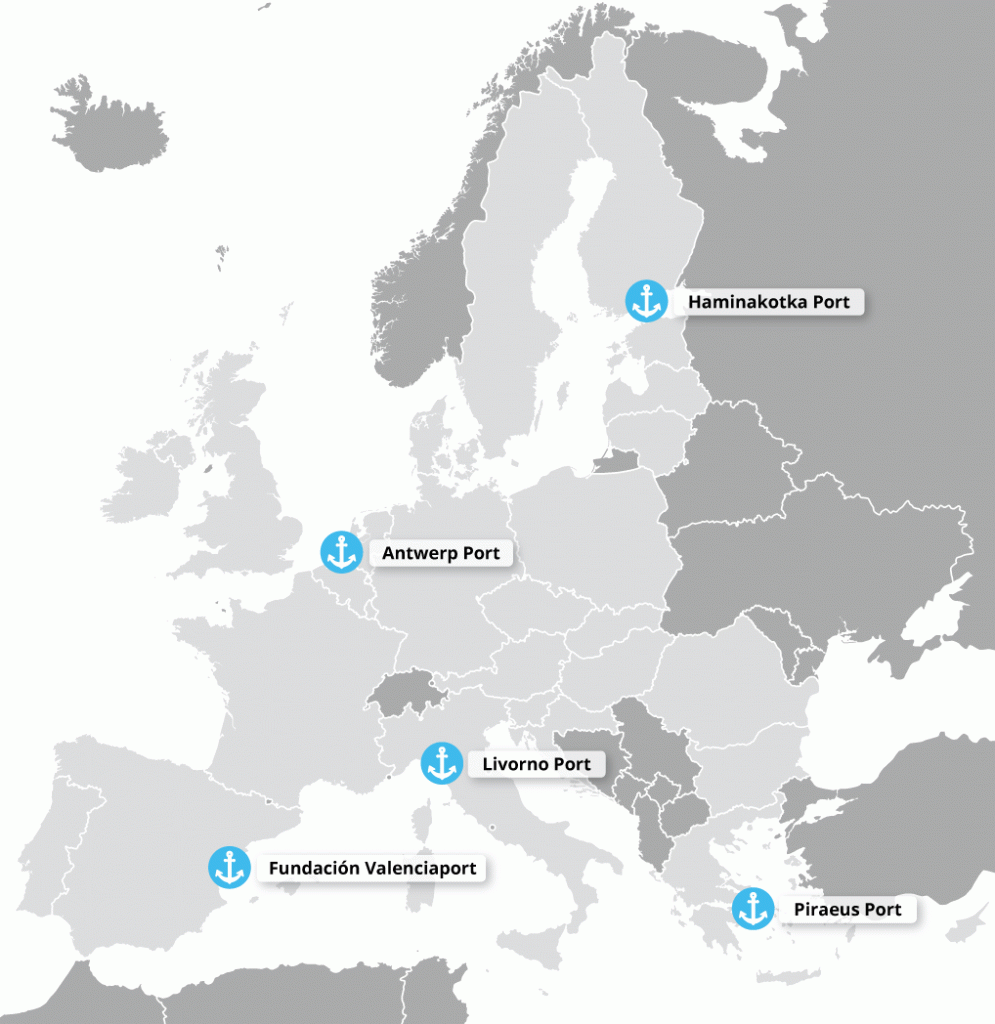
COREALIS also includes top-level EU research institutes, namely ICCS with vast experience in coordinating EU projects and in impact assessment for large scale field operational tests, VTT, with strong expertise in process modelling, Deltares, with expertise in port infrastructure development and in training tools for port operators, Fundación Valenciaport and CNIT, with a strong background in implementing IoT innovations and linking them to PCS. COREALIS comprises ERTICO, the top EU association in ITS for freight transport, large industrial partners: ERICSSON, the world’s leading provider of technology in Telecommunications, mobile networks and cloud services, Dynniq, experts in energy modelling and logistics business models, NEC, experts in machine learning/data analytics for transport and SGS, experts in logistics queue management systems; a set of innovative SMEs: MARLO, leader in cloud logistics platforms, SEAbility shipping company and dissemination expert, and MOSAIC, expert in data analytics for logistics.
Antwerp port
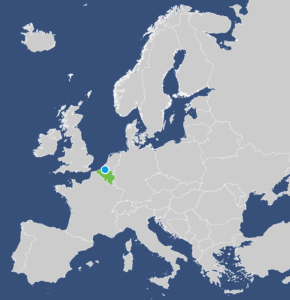
Antwerp port in a brief:
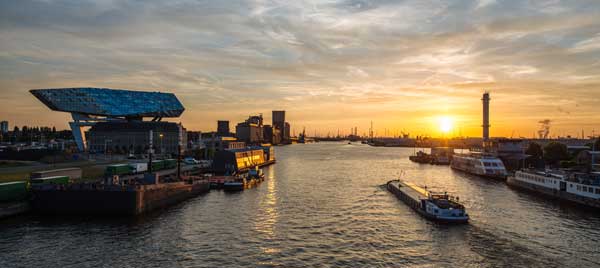
Port of Antwerp is Europe’s 2nd largest port, an important import/export port but also a very high value as transit port in Europe: it has more than 300 scheduled calls to more than 800 destinations. In 2017 the port handled an annual amount of 224 Mtonnes of international maritime freight. Antwerp is characterized as the biggest port area in the world: the area grew to exactly 12,068 hectares. In this area, the Port Authority gives land, warehouses, covering and quays in concession to companies to develop their commercial activities.
The central position of Antwerp provides its customers a vital link among biggest maritime and to Europe’s centres of production and consumption. Compared to neighbouring ports, Antwerp is the furthest inland (80 kms), allowing it to handle large volumes of freight. The Antwerp Port Authority seeks to achieve a better balance among the various modes of transport by switching to more sustainable options: rail and inland shipping, where further growth is anticipated. Antwerp is also at the junction of three major railway lines in Europe. Moreover, Antwerp’s location in the heart of the Rhine-Meuse-Scheldt delta means it has a direct link to the pan-European inland shipping network.
The Port Authority looks forward to the coming five years by developing a Business Plan, which foresees a Competitive Port and also paves the way for the development of the Antwerp port area under the terms of the Regional Land Use Plan. As stated in Port of Antwerp business plan (2018-2020):
‘’Port of Antwerp is home to a global centre uniting maritime and logistical services, industry and trade. Our mission is to bring together employees, customers and stakeholders, to strengthen them and to boost their development. We do this by empowering our employees, facilitating our customers’ success and aligning with our stakeholders. Our key drivers are adaptability, innovation and digitalisation. We create sustainable added value and act responsibly towards society.”
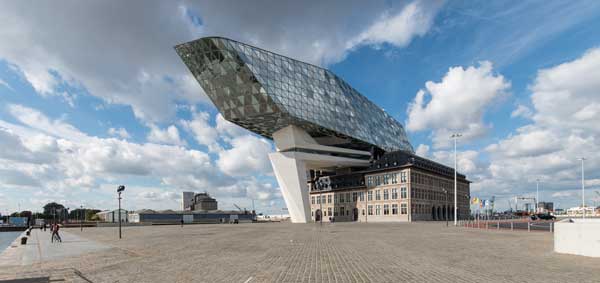
HaminaKotka port
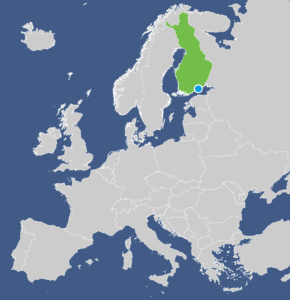
HaminaKotka port in a brief:
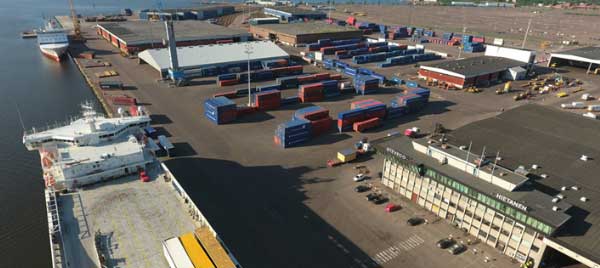
The port of HaminaKotka is the biggest universal, export and trans-shipment port in Finland, with regular connections to all major European ports. The main traffic consists of timber, paper, metal and stone. The location and transport connections of the Port of HaminaKotka render it a major transit route and a hub for all modes of transport. The port area of 1,100 hectares hosts almost 200 companies, is one of busiest Container Terminals (CT) in the Baltic Sea, and a liquid terminal specialised in the storage and handling of liquid goods. It also, provides full logistic services from production to final destinations, namely: vessel loading and discharging, forwarding, customs services, transport, ship’s clearance and terminal services. Kotka Container Terminal is the leading container terminal in Finland and the main transit port to Russia, for Finnish export goods.
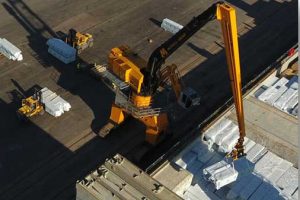 In 2016, port of HaminaKotka handled 13.4 million tons of cargo. The average tons of cargo per year is around 12,5 million (920.000 TEUs per year). The CT in Mussalo island (part of HaminaKotka port area) is the biggest CT in Finland and one of the busiest in Baltic sea. In 2016, its container traffic was ca. 631,000 TEU, but the terminal has capacity to handle annually 750,000 TEU. Steveco is the leading port operator in Finland and the market leader in the transport of the products of the Finnish wood-processing industry and in transit transport. Steveco Group has around 850 employees, of which about 500 are in Kotka.
In 2016, port of HaminaKotka handled 13.4 million tons of cargo. The average tons of cargo per year is around 12,5 million (920.000 TEUs per year). The CT in Mussalo island (part of HaminaKotka port area) is the biggest CT in Finland and one of the busiest in Baltic sea. In 2016, its container traffic was ca. 631,000 TEU, but the terminal has capacity to handle annually 750,000 TEU. Steveco is the leading port operator in Finland and the market leader in the transport of the products of the Finnish wood-processing industry and in transit transport. Steveco Group has around 850 employees, of which about 500 are in Kotka.
Livorno port
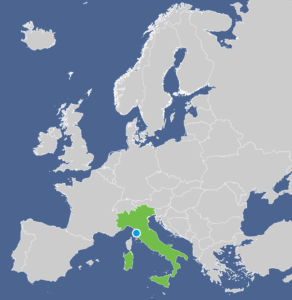
Livorno port in a brief:
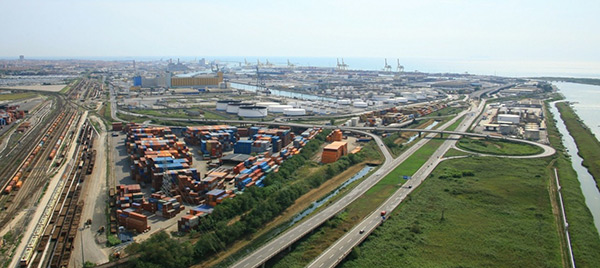
The Livorno port, favorably situated in western Tuscany, plays a major role in the European internal trade, ensuring frequent and fast maritime connections to southern European countries, as well as in the EU external trade, thanks to its well-established linkages to northern African countries and the Americas.
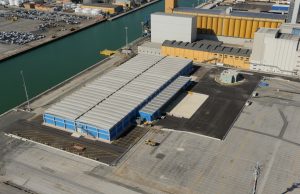 Port of Livorno is taking part in the digital revolution around the maritime transport: today, 780,000 containers per year, 2.5 million passengers (ferry and cruises). Moreover, there is a big investment in Livorno for the new “Darsena Europa” (Europa docks) to accommodate large vessels (up to 19,000 TEUs) matching requirements in terms of depth, length of docks, appropriate loading / unloading equipment, storage areas.
Port of Livorno is taking part in the digital revolution around the maritime transport: today, 780,000 containers per year, 2.5 million passengers (ferry and cruises). Moreover, there is a big investment in Livorno for the new “Darsena Europa” (Europa docks) to accommodate large vessels (up to 19,000 TEUs) matching requirements in terms of depth, length of docks, appropriate loading / unloading equipment, storage areas.
Livorno is also considered a pivotal node in the logistic chains linking the Mediterranean to central-east Europe. The port of Livorno is an ideal reference for implementing ICT solutions oriented to sustainable growth because:
- it is a mid-size port with a complex infrastructure yet expected to be relatively simple to interact with; the port and city are intertwined, as it often occurs in ancient (16th century) ports;
- it is multi-purpose, including a variety of operations – containers, cargo via Ro-Ro, ferries and cruises.
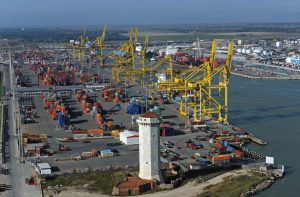 Autorità di Sistema Portuale del Mar Tirreno Settentrionale- ADSPTS (along with CNIT) is leading a deep digital revolution, making port industrial activities more efficient and safer. The authority aims for a complete digitalization of port operations, through R&D and technology transfer: gathering, aggregating and storing data from producers (i.e. machines and humans), interconnect them through a fast network; provide services to port communities. The Authority participates in the “5G for Italy” program, a collaboration platform founded by Ericsson and TIM and other Italian industries, universities and institutions, to experience innovative use cases in the port scenario. The Authority targets also innovation towards an integrated workspace for the water front and landside (docks and terminals, road and rail networks).
Autorità di Sistema Portuale del Mar Tirreno Settentrionale- ADSPTS (along with CNIT) is leading a deep digital revolution, making port industrial activities more efficient and safer. The authority aims for a complete digitalization of port operations, through R&D and technology transfer: gathering, aggregating and storing data from producers (i.e. machines and humans), interconnect them through a fast network; provide services to port communities. The Authority participates in the “5G for Italy” program, a collaboration platform founded by Ericsson and TIM and other Italian industries, universities and institutions, to experience innovative use cases in the port scenario. The Authority targets also innovation towards an integrated workspace for the water front and landside (docks and terminals, road and rail networks).
Piraeus port
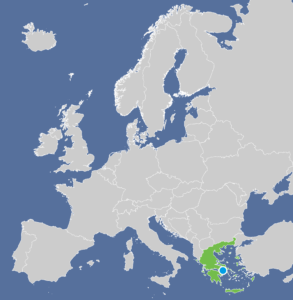
Piraeus port in a brief:
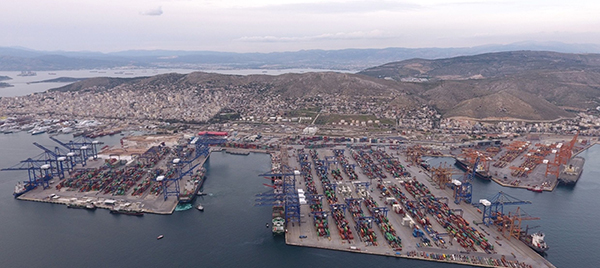
Piraeus Container Terminal (PCT S.A.), is a large dynamic company and terminal operator with promising prospects for the future, wholly owned by COSCO Shipping Ports Limited (former COSCO Pacific Limited “CPL”);
PCT has undertaken since 2009 the implementation of the Concession Agreement for Piers II & III for a period of 35 years.
PCT main activities are the provision of loading/ unloading and storage services for import and export containers handled via Piraeus, including cargoes which use Piraeus only as an intermediary station (transhipment cargo).
The strategic location of Piraeus makes it an ideal port to be used as the South Gate of Europe and a hub for destinations in the Central and Eastern MED and the Black Sea.
The terminal being the first European Port after Suez Canal with access to Europe’s mainland, handles Ocean traffic coming from major Asian-European routes, with a large feeders’ network with short sea shipping traffic serving Mediterranean and Black Sea ports.
PCT currently operates two Piers with total capacity of 5,6M TEUs (to be upgraded to 6,2M TEUs in 2019). PCT will be able to accommodate 4 Giga Carriers with no draft limitation + 1 Carrier of 10.000 TEUs vessel with maximum draft of 13.8 meters concurrently.
With 30+ QCs, 150+ trucks, 60+ yard cranes and operations increasing more than 20% annually, PCT needs to plan in advance on how to coordinate, maintain and improve operational efficiency in a feasible and sustainable way.
PCT goals are to offer high quality services to ocean carriers, to Greek importers and exporters & to freight forwarders; aiming to make PCT S.A. the largest port in the Mediterranean; to attract ocean carriers to use Piraeus as their transshipment hub in the area; to fully utilize the port’s connection with the railway network offering 10 days shorter transit time to Central Europe destinations; to promote the value of its infrastructure (port facility, warehouse, multiple vessel calls from Far East and China), in order to attract big multinational companies to use Piraeus as their hub for Southeast Europe, Africa and Black Sea.
Valencia port
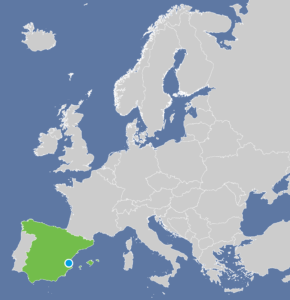
Valencia port in a brief:

The Port Authority of Valencia, which trades under the name of Valenciaport, is the public body responsible for running and managing three state-owned ports along an 80km stretch of the Mediterranean coast in Eastern Spain: Valencia, Sagunto and Gandía. Valenciaport is Spain’s leading Mediterranean port in terms of commercial traffic, mostly containerised cargo, moving more than 4.8M of TEU and 73M tons of cargo in 2017 thanks to its privileged location, its dynamic area of influence and an extensive network connecting it to major world ports and because of this, the leadership of Valenciaport is based on:
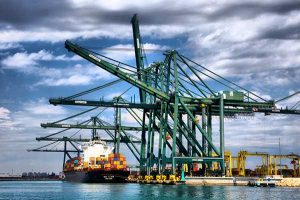 Privileged location: Valenciaport is the first and last port of call for regular shipping lines operating in the Western Mediterranean, providing the following advantages
Privileged location: Valenciaport is the first and last port of call for regular shipping lines operating in the Western Mediterranean, providing the following advantages
- The closest commercial port to the Suez-Gibraltar axis – the main route for interoceanic shipping lines.
- High capacity for concentrating and distributing traffic in the Western Mediterranean.
In addition, its geostrategic position on the Iberian Peninsula makes Valenciaport a natural port for interoceanic goods traffic by providing:
- Reduced land transport time.
- Well connected to distribute goods to and from all areas of the Iberian Peninsula.
Area of influence: Valenciaport is the perfect choice for any shipping lines because of its powerful area of direct influence – among the most dynamic in Europe – and its location close to southern European and north African countries.
- Valenciaport’s direct area of influence has a radius of 350km – an area that generates 51% of Spain’s GDP and includes half of Spain’s entire working population.
- Valenciaport is located in the heart of the Valencia Region, and has excellent road and rail connections to the centre of Spain, making it the ideal natural port for Madrid, and an essential platform for the entire Iberian Peninsula.
- As a hub for the entire Western Mediterranean, Valenciaport efficiently distributes goods over a radius of 2,000km, both in southern EU countries and in North Africa (Morocco, Algeria, Tunisia and Libya), representing a huge market of 270 million consumers.
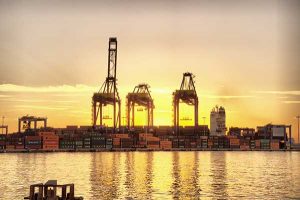 Interoceanic and regional connections with other major world ports: Valenciaport offers a complete network of connections with major world ports thanks to:
Interoceanic and regional connections with other major world ports: Valenciaport offers a complete network of connections with major world ports thanks to:
- Over 100 regular lines, among which are the world’s largest shipping companies.
- Multiple regional connections that give Valenciaport an extensive capillary network for goods transport.
Valenciaport is the best and most efficient option for maritime trade in southern Europe, with connections to over 1000 ports throughout the world. The Port Authority of Valencia has port and intermodal infrastructure that make port activities and goods transport highly efficient and with competitive charges and tariffs.
Guaranteed quality service: Valenciaport boasts a tightly-linked Port Community, due to innovative elements such as its Quality Mark and the valenciaportpcs.net technology platform, and comprising all public and private economic agents providing services through the ports of Valencia, Sagunto and Gandía


Truck Appointment System
COREALIS TRUCK APPOINTMENT SYSTEM
is a reservation system, including real time traffic data
Truck Appointment Systems (TAS) are a type of queue management solutions, which are generally found in different sectors of our society and economic activity (medical appointments, monuments visits, customs inspection, x-ray truck scanning, border-crossing points, vehicle inspection centers, etc.)
TAS (also named GAS – Gate Appointment Systems, VBS – Vehicle Booking Systems or TBS – Truck Booking Systems) are typically used in ports to regulate the incoming road traffic by spraying it over the day to match the capacity and the infrastructure of the terminals. This helps terminal and transport operators to optimize their operations and, in its turn, reduces congestion at the port gates and surrounding city areas, truck turnaround time within the port and overall pollution levels, amongst other.
Paradoxically, despite its proved multiple benefits, one of the major drawbacks for the use of TAS is their generally limited use by the different port community operators. The explanation for this is that digitalisation is still a pending issue in many traditional logistic operators and even though efforts are being made to become 4.0 enterprises and smart ports, assimilation of new tools by employees takes its due time and must be accompanied by employees’ training and a well-thought phased implementation process.
Aware of this, COREALIS TAS has been devised as a modular system that can be upgraded, integrated into other systems and complemented with other solutions as new challenges arise and users are prepared to handle them.
COREALIS ADVANCED & LIGHT TAS:
Under COREALIS project TAS has materialised in two customized versions: light and advanced, which have been tested at the ports of Valencia (ES) and HaminaKotka (FI), respectively, two ports of different dimension, logistic operations and operators’ needs. The obtained results have proved satisfactory, promising, and provide a real scenario for mirroring its future to any other port wishing to become digital and innovative.
In search of a distinctive approach from other TAS solutions, the COREALIS TAS has different characteristics that make it unique and a fast-return investment:
- Web-based platform accessible from any device with Internet connection. No specific software or additional hardware needed
- Complementary mobile application (for IOs and Android) allowing multi-sided communication with drivers and geolocation tracking
- Modular solution for adapting to each port’s needs
- Multi-phased implementation for a smooth assimilation by stakeholders and effective integration in daily activities
- Evolving, scalable, likely to integrate with different platforms and data: terminal operation systems, port community system, gates system, customs clearance and inspection appointment system, vessel arrival/departure schedules, security and pass issuance, biometrics, OCR, weather forecast, city traffic, etc.
TAS MODULES:
The advanced COREALIS TAS includes the following modules and functionalities:

- Capacity Management module for container terminals/ports
- Appointment Management module for transport operators
- Dashboard and reporting module for TAS users
- Secure user register and profile configuration
- Real-time truck geolocation providing ETA (Estimated Time of Arrival), real trip duration and driving status allowing real-time operations monitoring by TAS users
- Dynamic rescheduling and operations optimization based on real-time information (including remote rescheduling by drivers)
- Communication Module between drivers, transport companies and terminal operators
- Statistics module for monitoring, reporting and KPI analyses
CONTINUOUS INNOVATION:
The TAS solution, in both its advanced and light version, is ready to be replicated in other EU ports. Its modularity and upgradeability allowing its implementation in ports of different sizes and specifics in the European Union, adapting its functionalities and features to the specific requirements of each of them.
Moreover, TAS can be complemented with other solutions such us: single window, scanning inspection services, transit management solutions, e-customs and illegal trade fighting services, advance cargo information platforms or legal trace systems, to mention just a few.
SGS TAS added value lays in SGS experience and expertise in trade facilitation services worldwide helping to overcome the initial difficulties in implementing digital solutions whilst being advised, trained and supervised throughout the project life by experts.
More detailed information on TAS and trade-facilitation solutions can be found here.
POSITIVE IMPACT:
As a matter of fact, the implementation of a TAS has proved positive impact in different sectors. In 2011, for example, a similar solution was deployed at three European borders between Estonia and Russia. Since its implementation:
- The average queuing time for trucks was reduced from 60 hours to 2 hours
- The local transport industry declared a annual saving of 4 million EUR (as declared by the Association of Estonian International Road Carriers)
- Sanitary, waste and pollution issues as well as illegal practices have been resolved
In April 2017, GCT Bayonne USA successfully introduced an appointment system. At first the appointment was only required between 6am to 10am, showing an improvement of 38% lower turn time. It was then extended hour by hour as the booking increased on the platform.
Similarly, COREALIS TAS has showed positive results during the initial pilot phase (i.e. port of HaminaKotka: 27% reduction of trucks arriving late, and all trucks arriving within their appointed 30-min slot) and drastic improvement is expected after the full deployment and consistent use in both ports of Valencia and HaminaKotka by December 2020.
COREALIS Truck Appointment System has been developed by SGS.
SGS REFERENCES & PARTNERSHIPS:
https://schedule.sgsauto.com/aspx/Default.aspx
https://www.worldsummitawards.org/winner/goswift-online-reservation-system-for-border-crossing/
Marketplace & Chassis Brokerage Platform
COREALIS BROKERAGE PLATFORM
is a Cloud based marketplace for leasing and exchanging intra-port assets
DESCRIPTION OF THE INNOVATION
The Marketplace solution steps into facilitating demurrage, handling movements as well as communication among actors in the chain but also within the port itself. Port of Antwerp indicated the need for a dedicated platform where their stakeholders can exchange offers of their assets on time bases to reduce unnecessary investments in equipment used occasionally. The biggest stakeholders in the port have their own assets that have been idle for a major part of their time that could potentially be used by someone else for a fee. Integrating the Marketplace with tracking devices and demands from terminal operating systems creates potential benefits for all of the stakeholders. The system has been built on the basis of the requirements from the Port of Antwerp however it will be customized to the needs of a port of use each time. The basic version consists of five modules:
- Users, where the administrators can manage their users’ accounts;
- Resources allows adding, editing and deleting equipment to be rented;
- Reservation that allows users to reserve a resource and view the reservation schedule;
- Settlement used to generate settlements between participants;
- Integration for data exchange information with other ICT systems (e.g. port community system), including exporting data to users’ calendars;


BENEFITS FOR PORTS
Marketplace solution facilitates optimization of the use of specialized equipment being held in the port such as: train wagons, cranes, barges, chassis, etc. On the basis of plans delivered by ports it calculates needs of the equipment in numbers as well as in space as the Marketplace offers a localization service that can be set to a particular place in the port and linked to the assets also being localized on real-time bases. Port, together with its stakeholders needs to create a database of their assets so that it is shared within the ecosystem and commonly used. Apart from automatic calculation also manual booking option is available so that user can browse available equipment and book it on selected criteria. All categories of assets have mandatory and optional criteria list.
As a result of the enhanced planning of equipment and services the port will receive information over the more efficient layout of containers and knowledge on operators picking them up. This results in a shorter time of container staying at port and a better yard utilization on the terminals.
For a carrier or shipper, the equipment optimisation and availability information lead to a shorter waiting time at the port and a lower demurrage risk due to better planning and real-time equipment localization monitoring.
LEVEL OF TRANSFERABLITY
Custom functionality of the Cloud-Based Marketplace has its base on the requirements proposed by the Port Authorities after consultations with their Stakeholders. Every implementation should be preceded by a list of common requirements and data interfaces. Some of the functions of the Marketplace (dashboard or TOS file format) can be customized as per case. As a standalone solution Marketplace is independent from other systems however needs to be fed with proper database of assets that will be continuously kept. Interfaces to TOS systems also need to be set prior to its full implementation.
COREALIS Brokerage Platform has been developed by MARLO.
PORTMOD
COREALIS PORTMOD
is a visualisation and simulation tool for Container Terminal operations

CHALLENGE
The changing customer demand puts pressure on terminals to adapt to new situations in order to be cost-efficient. Terminal Operating System (TOS) are used to plan, schedule and control equipment, but currently they cannot perform what-if analyses to study port operations in alternative future scenarios. Sometimes Commercial-Off-The-Shelf simulation software like CHESSCON, CONTROLS or Arena Simulation Software can be used for this purpose. However, in other cases, they may be found too expensive or their customisation capabilities may be found too limited. In order to speed up the improvement of efficiency of European terminals, other solutions are also needed.
SOLUTION
PORTMOD is a free standalone Java program that addresses container-handling challenges at a container terminal. It is built on open-source components, where the visualisation is powered by JGraphX and the simulation is powered by DESMO-J. It can visualise container movements in a terminal, where the input data may have been extracted from a Terminal Operating System (TOS). In addition, it offers limited simulation capabilities in order to estimate some efficiency improvements. PORTMOD may be used for the following purposes:
- Identify inefficiencies and bottlenecks in container flows
- Identify inefficiencies in straddle carrier and crane operation
- Estimate the benefit of machine pooling during ship loading and unloading operations
Furthermore, thanks to its open-source components, simulation capabilities can be added on case-to-case basis.
BENEFITS FOR TERMINAL OPERATORS
Flows of import and export containers in a terminal may change over time. The usage of the container yard(s) and other storage locations may be adapted to better cope with the new situation. A virtualisation provided by PORTMOD can assist in providing an overview of container flow quantities over time and, therefore make it easier to identify bottlenecks and find solutions. In addition, with PORTMOD the efficiency improvement of using machine pooling during ship loading and unloading operations can be analysed. With operational efficiency, we here refer to ship unloading and loading speed, as well as to idle times for cranes and straddle carriers. In machine pooling the straddle carrier jobs are centrally distributed and, therefore we typically can reduce idle times compared to the current strategy, which may be that each straddle carriers is designated to serve a specific crane. Furthermore, the simulation can be executed with a reduced number of straddle carrier in order to see how it affects the operational efficiency.
LEVEL OF TRANSFERABILITY
PORTMOD may be used in any container terminal using manually operated straddle carriers; however, some customisation is likely to be needed in addition to the normal setup procedure. PORTMOD requires input from a TOS, e.g. NAVIS, and, therefore the TOS should be able to produce the PORTMOD required input or, alternatively a tighter integration with the TOS system should be developed. Furthermore, it is likely that the simulation capabilities need customisations on case-to-case basis. Please do not hesitate to contact in case you want a copy of the software or have any questions.
COREALIS PORTMOD is developed by VTT Technical Research Centre of Finland Ltd in collaboration with Steveco Oy.
A showcasing demo can be watched here.
The PORTMOD related COREALIS videos are:
- COREALIS Webinar: Living Labs as a stepping stone to the Port of the Future (available here)
- Training Seminar of COREALIS HaminaKotka Living Lab: Increasing efficiency step by step (available here)
- COREALIS Final Conference (available here)
Contact: Toni Lastusilta, toni.lastusilta@vtt.fi (VTT)
RTPORT
COREALIS RTPORT
is a Model-Driven Real-Time control module supporting 5G smart terminal operations
DESCRIPTION OF THE INNOVATION
The Model-Driven Real-Time Control Module (RTPORT) is designed to coordinate and support port operation in real time, collecting data via yard vehicles and implanted sensors and taking operating decisions based on real-time analytical processing.
![]()
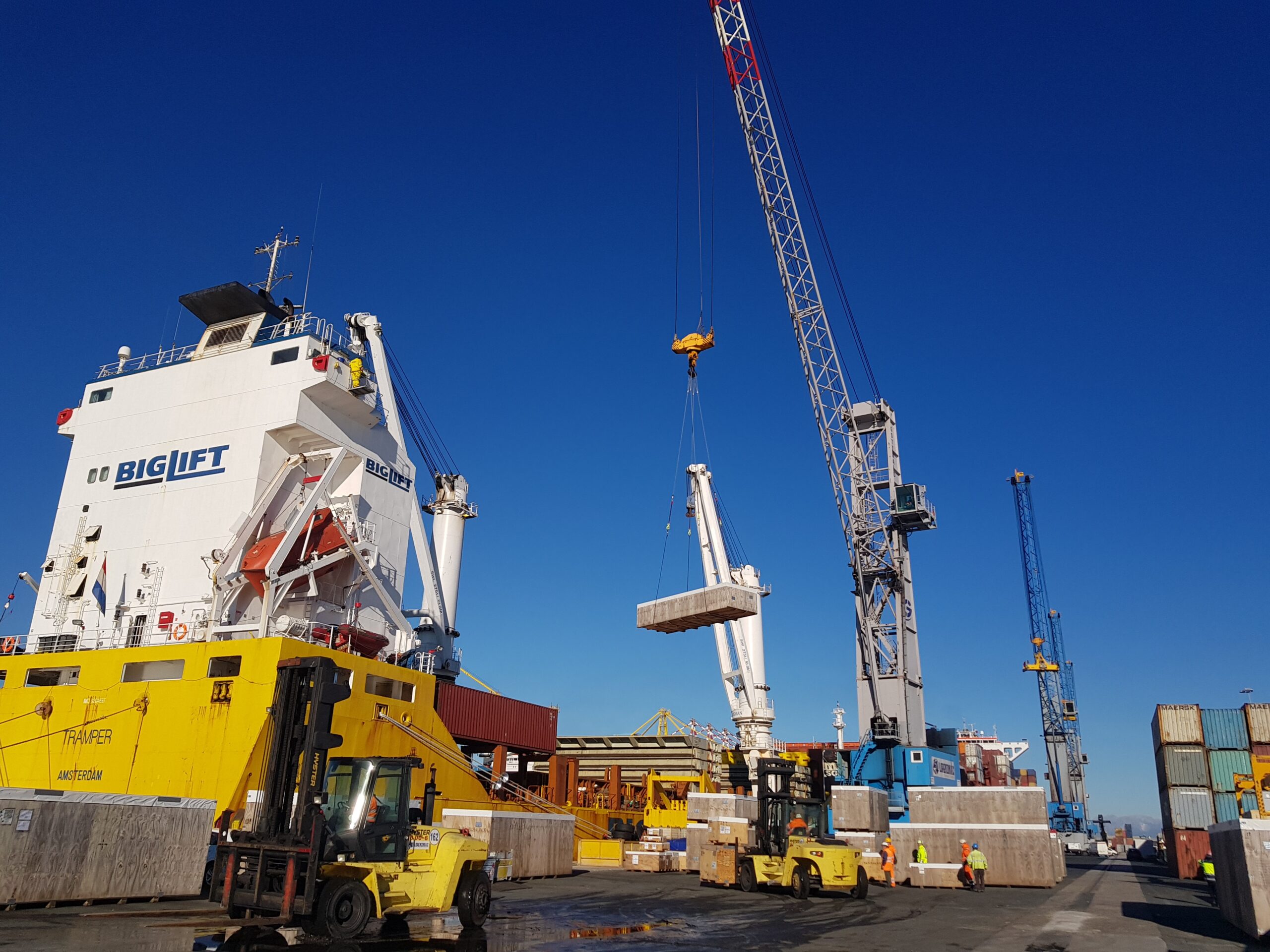
The RTPORT module aims at providing a fully automated system for the management of the general cargo within the Container Terminal area. The main aim of the RTPORT module is to design and set up a pervasive 5G network in a Container Terminal providing advanced assisted services to the Container Terminals operators.
The general cargo registration phase can be watched here.
The general cargo loading phase can be watched here.
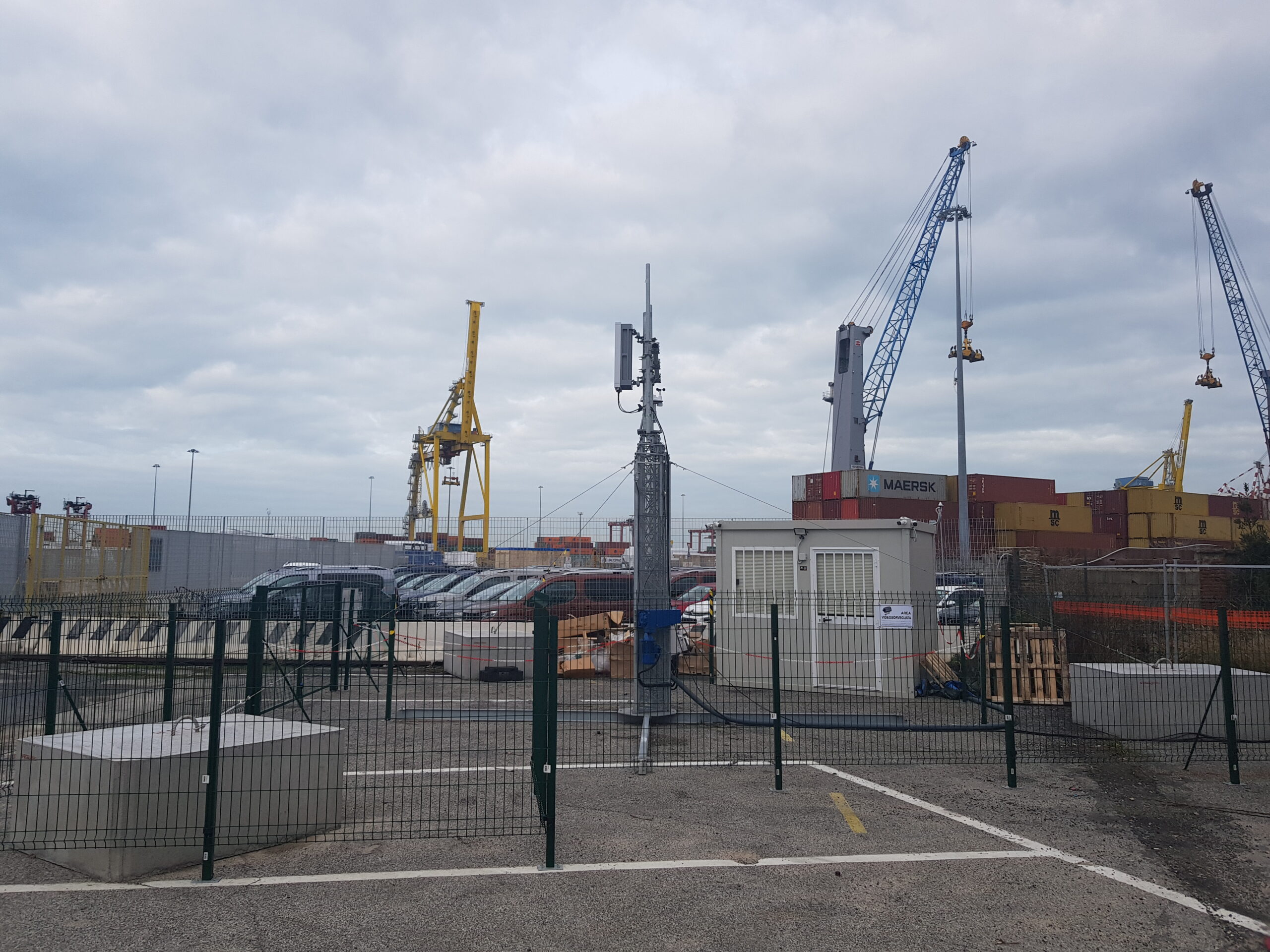
RTPORT module will allow to pick up 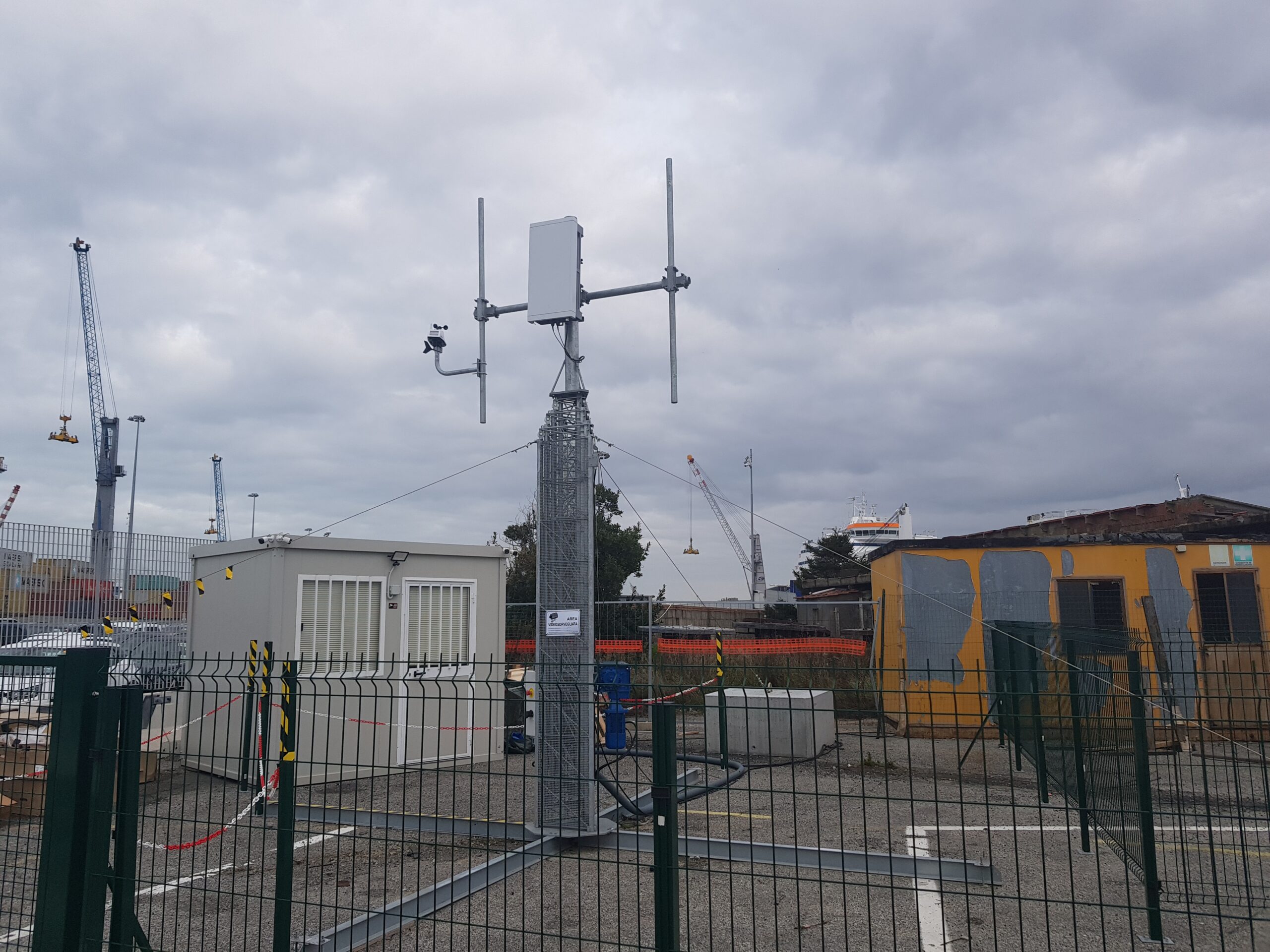 the specific general cargo in a shorter time than by means of usual human-driven communications. It will also allow a better management of the cargo in itself (optimal placement, optimal forklift call and optimal loading/unloading operations) by means of VR/AR-based devices/services.
the specific general cargo in a shorter time than by means of usual human-driven communications. It will also allow a better management of the cargo in itself (optimal placement, optimal forklift call and optimal loading/unloading operations) by means of VR/AR-based devices/services.
This will reduce significantly the total number of operations per unit and will improve the intra-terminal operational efficiency.
BENEFITS FOR PORTS
RTPORT is designed to improve the intra-terminal operations efficiency. Its validation is expected to be performed by means of benchmarking tests based on operational KPIs: vessel operation completion time, loading/unloading operations completion time, time to find a cargo within the storage area, occupied space during cargo storage operations, vessel idle time at berth, amount of available data related to the cargo, total movements per cargo unit and average time of activity/inactivity of the forklifts.
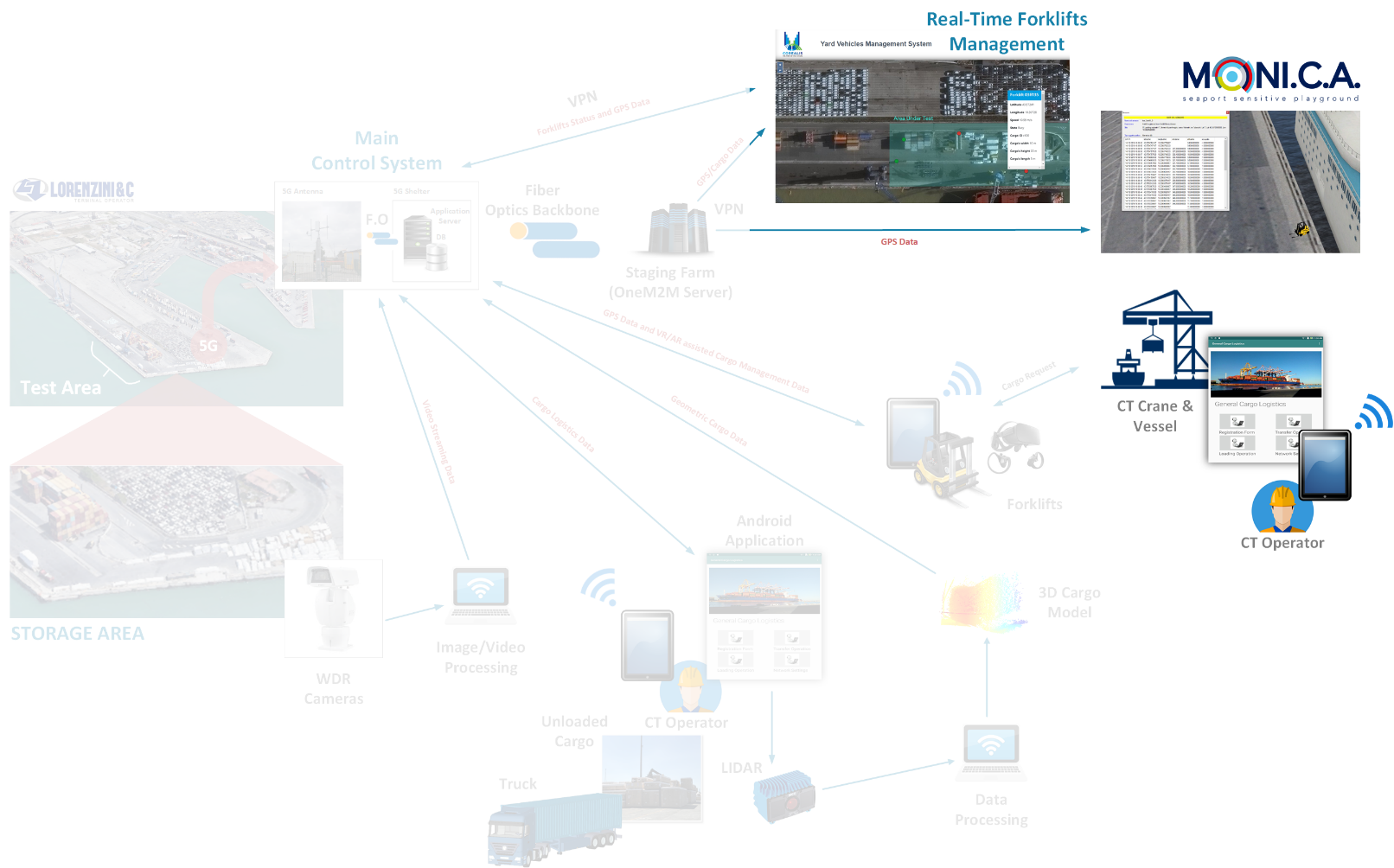
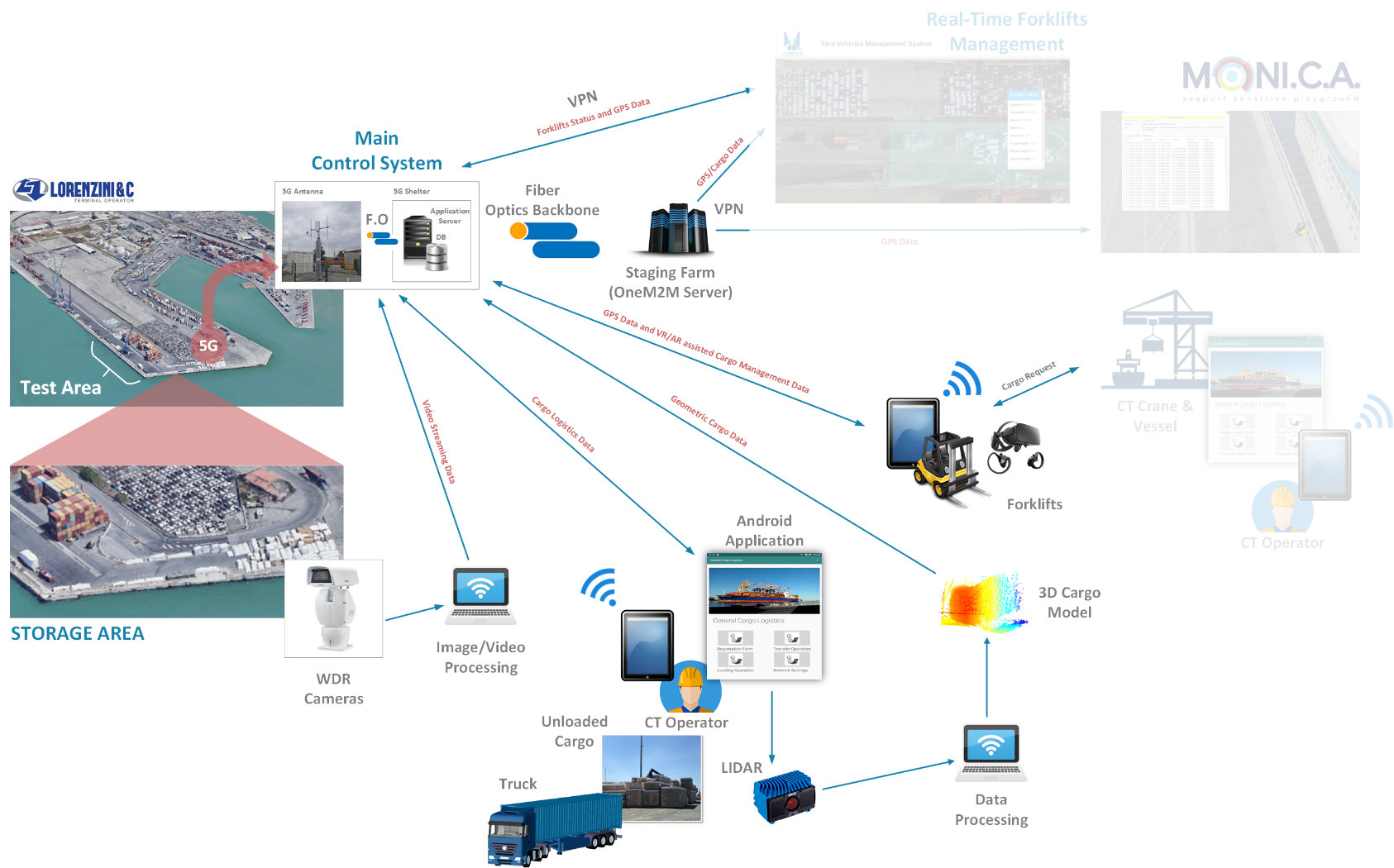
Based on this assessment, it will be possible to identify qualitative and quantitative benefits for the port in terms of cost savings and environmental footprint (less fuel consumption due to optimized yard vehicles management and less CO2 emissions).
On the other hand, optimized general cargo management will bring benefits to the Container Terminal as well avoiding, where possible, potential operational inefficiencies and improving the way these kinds of operations are currently carried out.
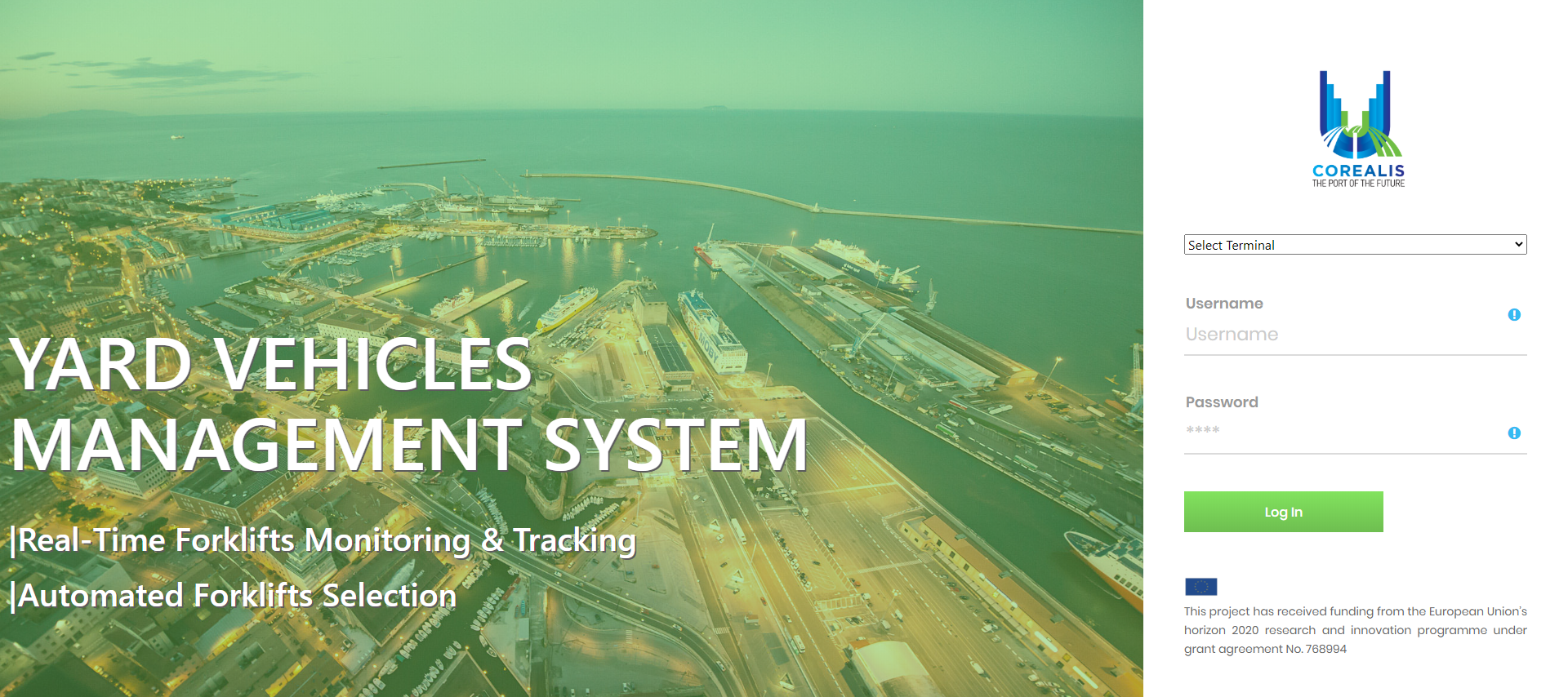
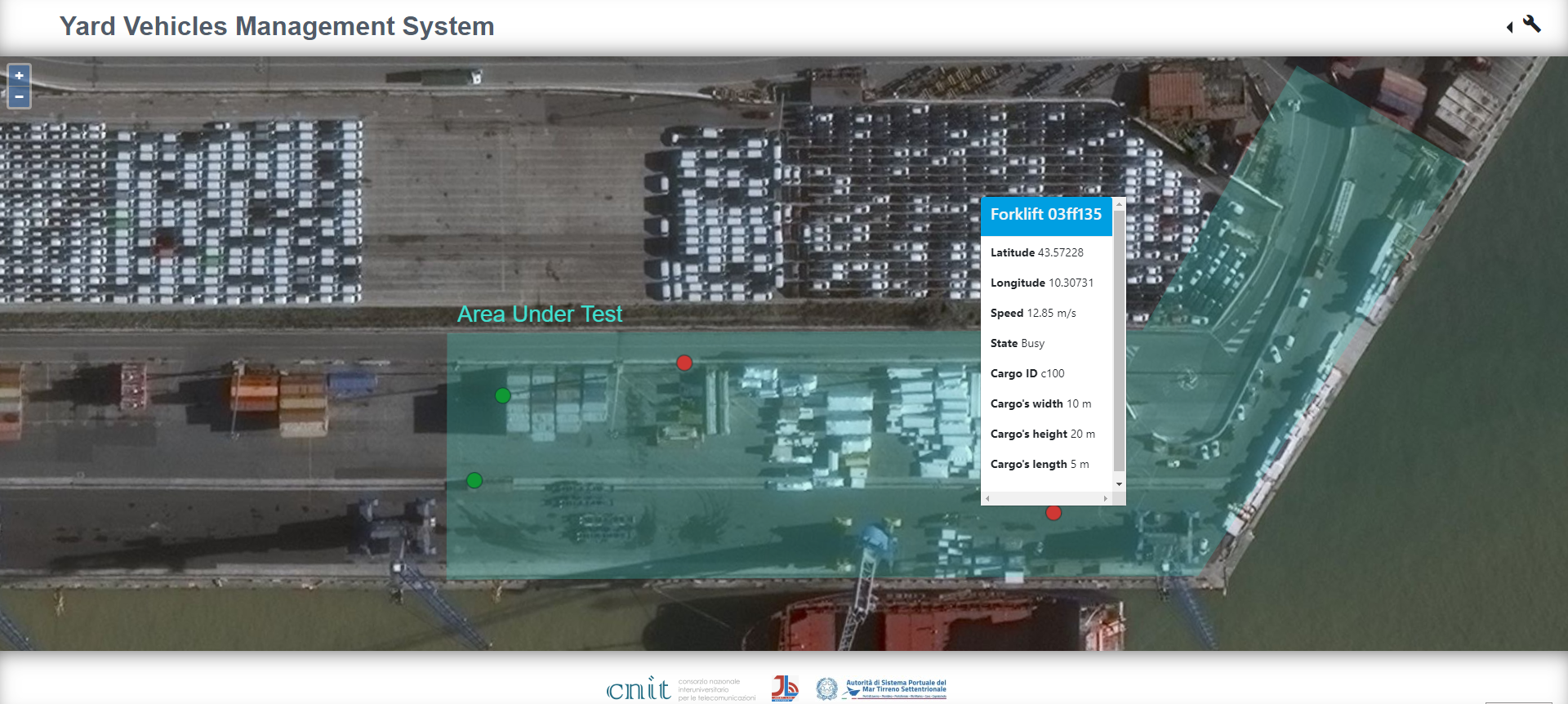
LEVEL OF TRANSFERABLITY
The experimentation of the RTPORT module in a container terminal of the Port of Livorno (chosen as the test bed) aims to instantiate a pervasive 5G network and to demonstrate how the interconnection of IoT devices, through machine-to-machine standards (ie: OneM2M Standard Platform ), is in line with the ITU IMT-2020 technical requirements regarding mMTC communications (massive Machine Type Communications). Despite this, the functionality of the RTPORT module is closely related to the usage of the proper radio technology: the 5G allows to reach high data rates, higher throughput, lower latencies, high service availability, very high user density and high energy efficiency, compared to fourth-generation technology such as 4G (LTE). If in some cases, such as Virtual Reality (including real-time video streams from WDR cameras), these requirements are mandatory, for the others (i.e. augmented reality, vehicles tracking, etc.) this does not appear to be true. For this reason, the initial solution includes an overlapping with the existing 4G technology so that switching operations are possible. This means that radio technologies of generations preceding the fifth can be used to provide similar services even if with limited capacities (4G technology is not able to support, for example, a high number of connections per unit area or advanced features such as Network Slicing with a differentiated quality of service). It is also up to the operative context the container terminal operates in: for example, some terminals may not be interested in having a real-time assistance service during the cargo’s handling operations, delivered via viewers and / or tablets with Virtual Reality. In this case a last generation, low latency and high availability network may not be strictly necessary, even if it would penalize the efficiency of the operations.
COREALIS RTPORT module is developed by ERICSSON team and supported by CNIT.
COREALIS Asset Management Predictor
COREALIS ASSET MANAGEMENT PREDICTOR
is an optimization, machine learning tool for efficient use of port assets
Predictive Maintenance (PdM) is an imbalanced classification problem where number of part failures is much smaller than predominant normal working parts.
COREALIS Asset Management Predictor tool goes beyond the statistical analysis or classic Enterprise resource planning (ERP) preventive maintenance tools by realizing a powerful predictive analytics module, using advanced machine learning algorithms tailored for imbalanced classification tasks.
Using COREALIS Predictor, the port has a Just-In-Time Inventory, optimizes its renewals decisions and supports circular economy towards allowing a longer use/reuse of port assets.
The process followed was to:
 Define Preventive vs Predictive Maintenance:
Define Preventive vs Predictive Maintenance:
- Preventive Maintenance: Engineers inspect vehicles every couple of months. This method is costly and does not capture asset-specific conditions (for e.g. rides per day, occupancy level, weather conditions, etc.).
- Predictive Maintenance (PdM) solutions take into account the operating conditions of vehicles by leveraging data collected from individual assets to predict failures in future.
Overview PdM solution through:
- Data Collection: Equipment Data and Maintenance Data
- PdM Platform: Preprocessing and Training AI Model
- Outputs: Schedules, Overview of Assets and Purchase Optimization
Guarantee the Customer Value via:
- Reduced Asset Downtime
- Reduced maintenance and repair costs
- Optimizing spare parts inventory
The overall module is designed and developed by NEC.
Cargo Flow Optimiser
COREALIS CARGO FLOW OPTIMISER
is an optimization tool for ocean/rail/inlandwaterway cargo flows
Optimisation of Port Hinterland Mobility
Multimodal Inland Planner
Complete overview of the most efficient connections from Port of Antwerp to its hinterland by rail, barge or truck.
Calculates the optimal door-to-door container routes comparing the duration, price and CO2 emissions.

Cargo Flow Prediction
Forecast model of the flow of containers departing from the Port of Antwerp, it predicts the container destination and mode of transport by means of historical and real-time data.
The accuracy of predicting cargo operations contributes to the planning and control in port terminals and increases reliability and resiliency of port operations in an ecosystem with high uncertainties and a turbulent and ever-shifting demand.

COREALIS Cargo Flow Optimiser has been developed by MOSAIC.
Port Of The Future Serious Game
COREALIS PORT OF THE FUTURE SERIOUS GAME (PoFSG)
is an innovative and interactive training and simulation game for port-city developments
DESCRIPTION OF THE INNOVATION
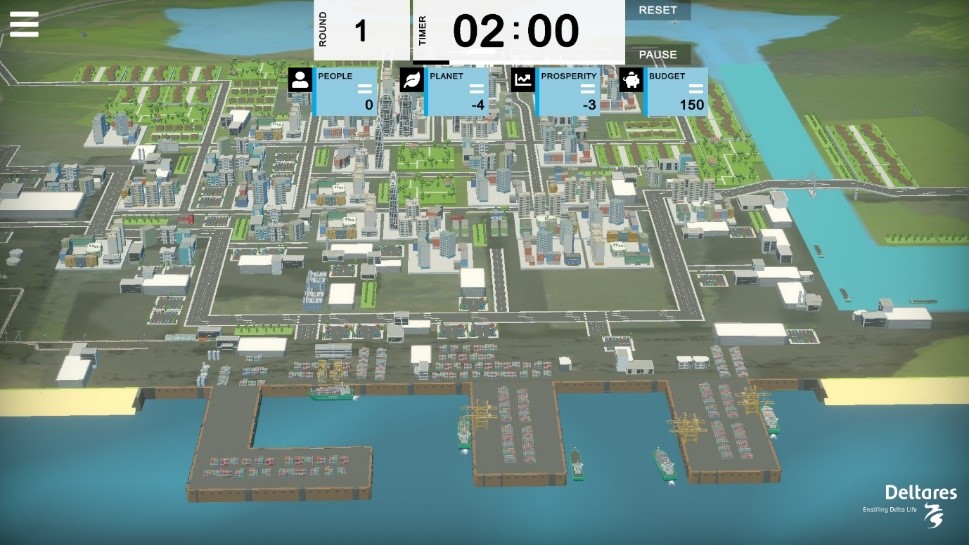
The Port of the Future Serious Game (PoFSG, ©Deltares) is an innovative and interactive training and simulation game that is used to explore the feasibility and sustainability of port-city developments. The game aims to raise awareness on present and future port-city challenges (such as the energy transition, digitisation and climate change adaptation), by letting stakeholders explore the impacts of their actions in a virtual but realistic port setting. The PoFSG can be used to stimulate discussions and debate amongst stakeholders and/or for educational purposes. The game contains qualitative progress indicators describing the effects of different scenarios and measures on society (people), the natural environment (planet), and the economy (prosperity), also referred to as PPP. The desired outcome of the game is to achieve sustainable growth for people, planet and prosperity, resulting in a balanced increase in the PPP indicators. The PoFSG is a multi-stakeholder game where players are subdivided into different stakeholder groups. The players are asked to represent different stakeholder perspectives and decide together which measures should be implemented to balance the progress on PPP in their decisions. The game consists of a facilitator, a digital simulation environment (software), game cards (with stakeholder roles, measures, scenarios and events) and a facilitator guide.
BENEFITS FOR PORTS
The target audience of the PoFSG are port planners and stakeholders that want to explore future port-city management strategies. The PoFSG can be used to achieve several goals. First, the game can help port-city stakeholders to explore, better understand and discuss different port development aspects based on the three pillars: People (society), Planet (environment) and Prosperity (economy). Second, the PoFSG can assist in educating players on integral and multidisciplinary thinking by combining requirements for port infrastructure and operations with those of ecosystems and society. The game makes trade-offs between these requirements and the allocation of financial resources explicit. Third, the PoFSG facilitates debate and negotiation between stakeholders and stimulates players to account for different stakeholder perspectives in their decisions. The game can be played in workshops as a part of the stakeholder engagement process.
LEVEL OF TRANSFERABILITY
The PoFSG is based on a fictional but realistic port environment, which makes the game easily transferable and applicable to different port developments. The game facilitator can select scenarios, events and stakeholder roles from a wide range of options to adapt the game setting to the local context. Moreover, the facilitator can use elements from the real port context in the introduction and evaluation of a PoFSG workshop. The game rules are kept simple to make the game accessible for a wide audience. Furthermore, the game is accompanied by an interactive simulation environment, which provides visual feedback to the players and makes it easily accessible. Port that are interested in a PoFSG workshop can either buy a copy of the game or arrange a workshop session at their port.
A showcasing video can be watched here.
MORE INFORMATION
The Port of the Future Serious Game is developed by Deltares, an independent knowledge institute on water, soil and infrastructure from The Netherlands: https://www.deltares.nl/en/
For more information on the PoFSG, acquiring the game or arranging a workshop, please contact Deltares via: https://www.deltares.nl/en/software/port-of-the-future-serious-game/.
Green Cookbook - Just-In-Time (JIT) Rail Shuttle Service
COREALIS Just-In-Time Rail Shuttle Service
is a feasibility study for key port-hinterland corridors
THE CHALLENGE
The growth in container transport volumes and the increment of vessels’ size, including mega-ships calling a limited number of hub ports, make necessary to increase the capacity of port-hinterland connections to manage cargo concentration. Currently, road transport represents the highest share in Europe´s port-hinterland connections, resulting in port congestion, which is associated with delays, queuing and dwell of ships and cargo in ports. This translates into extra costs and negative environmental impacts. Therefore, in response to this major challenge of ports, rail transport should play a key role as a sustainable response to this need, making necessary the development of innovative solutions able to face the current problems and limitations through a more collaborative approach between port stakeholders.
THE SOLUTION
The Just-In-Time Rail Shuttle Service feasibility study pursues to boost the rail transport mode and increase its modal share in the Port of Valencia by assessing new services and business models for key port-hinterland corridors of the port, such as the Valencia-Zaragoza rail corridor that is assessed in the study.
The solution aims to minimize container movements in the terminal and optimize the loading/unloading operations of container cargo. It includes the design of the physical and operational solution (service characteristics), the information system requirements and the definition of a business model for its potential implementation that will help to attract more shippers to use rail freight due to cost reduction. In order to achieve this ambitious challenge, the JIT Rail Shuttle Service feasibility study covers following aspects:
i. Improve/develop rail infrastructures (rail access to ports, rail infrastructure at port terminals, rail connections with dry ports and inland terminals) in order to reduce transit time, which has an important effect on just-in-time distribution systems.
ii. Minimise handling movements per container at port terminals: containers aim to be directly unloaded from the vessel and loaded onto trains without being stack at the terminal yard.
iii. Increase the length of trains and the number of wagons to decrease operational costs.
iv. Reduce container dwell time (time taken for exports inside terminal gates to be loaded onto a ship and imports onto a truck or train): shorter dwell times enable cargo owners to save on storage charges applied by port terminals.
v. Improve communications among port-rail actors in the logistic chain for a better planning of loading/unloading operations: currently, port terminals receive information about if the container will be loaded in a rail service once the vessel arrives and the container is unloaded and moved to the storage areas, which result in a waste of time, lack of efficiency in the supply chain and extra costs.

BENEFITS
The JIT Rail Shuttle service proposes to operate as an “air bridge” at airports but for container cargo instead of people. It aims to directly unload the containers from the vessel and load them onto trains, minimising handling movements in the terminal and then doing roundtrips in a particular route within a day where the containers are loaded into the first available JIT rail service. The main successful factor for the JIT Rail Shuttle Service implementation is the cost, which is key to attract shippers to use rail instead of the road transport. Thus, the optimal solution for the JIT Rail Shuttle Service implementation is the one that minimises the cost per unit transported (minimum cost per TEU). Besides, the study reveals that the implementation of the new JIT Rail Shuttle Service requires important changes that affect the current information flows and roles. This is positive because it will push port-rail stakeholders to enhance digitization processes and also stakeholders’ collaboration, providing greater train utilization, flexibility, frequency, regularity of the service and minimizing the costs per unit transported.
LEVEL OF TRANSFERABILITY
The assessment of the JIT Rail Shuttle Service in a key port-hinterland corridor of the Port of Valencia (Valencia-Zaragoza rail corridor) can be easily replicated in other port-hinterland corridors not only in the Port of Valencia but also in other European ports with high potential for rail cargo. The study sets up the basis of the analysis to be covered in other rail corridors but it can be featured and adapted to other European ports that present different rail corridor characteristics’ (distances, types cargo or traffics). The information systems requirements and the business model presented in the study have been adjusted to the needs of the Port of Valencia but both can be replicated and fine-tuned to the specific requirements of other European ports.
COREALIS JIT feasibility study has been drafted and documented by VPF.
Green Cookbook – Energy Assessment Framework
COREALIS ENERGY ASSESSMENT FRAMEWORK
is a cost benefit analysis and roadmap for reducing port’s environmental footprint
An energy assessment framework has been created for ports in general and the Piraeus Container Terminal (PCT) in particular. The energy assessment investigates the cost-effective integration of renewable energy sources (RES) with energy storage in the port environment. The overall objective is to cover a significant part of the ports load demand with renewable energy within the constraints of the current grid connection at a competitive price.
 A purpose-built simulation environment tracks the power-flows between the renewable generation, battery storage, load and grid connection. Additional constraints are taken into account, such as the power of the grid connection and the power and energy content of the battery storage. The simulation optimizes different objectives such as peak shaving of the renewable generation and load demand, maximization of the self-consumption of the renewable energy, maximization of the self-sufficiency of the load demand by the local generation and storage and determines the RES curtailment.
A purpose-built simulation environment tracks the power-flows between the renewable generation, battery storage, load and grid connection. Additional constraints are taken into account, such as the power of the grid connection and the power and energy content of the battery storage. The simulation optimizes different objectives such as peak shaving of the renewable generation and load demand, maximization of the self-consumption of the renewable energy, maximization of the self-sufficiency of the load demand by the local generation and storage and determines the RES curtailment.
This allows us to analyse the energy consumption of the port, the flexibility offered by battery storage, the grid-interaction, the cost of the different solutions and the achievable CO2 reduction.
Next to the RES integration, a further improvement in the environmental impact of the port is elaborately investigated by replacing the entire fleet of diesel driven yard vehicles, mainly terminal tractors, with electric vehicles. This saves 2,5 million liters diesel per year, while the return on investment of the electric vehicles, including the charging infrastructure, is less than 4 years.
A final investigation attempts to reduce the harmful emissions from on-board diesel generators by providing Onshore Power Supply to the ships. Within the current grid-limitations about half of the ships can be provided with electrical power.
The conclusions of the Energy Assessment Framework:
- Renewable Energy can be provided at competitive prices at around 60 €/MWh, which is below the current electricity price. This includes the battery storage which is quintessential to cope with the load demand and RES-production peaks.
- The 55 GWh load, including Electric Vehicles and Onshore Power Supply, is covered by 46 MW of renewable generation and 30 MWh battery storage. The self-sufficiency exceeds 85% with renewable electricity that emits 25 g CO2/kWh compared to current levels of 1167 g CO2/kWh.
- Excess generation allows the port to become a net-exporter of renewable electricity and as such allows the port to contribute to the national green energy targets instead of being considered as a main contributor to the pollution.
- The introduction of Electric Vehicles can save millions of litres of diesel fuel annually. Contrary, the impact on the electrical consumption is limited and represents 10 % of the current consumption.

COREALIS Energy Assessment Framework has been drafted and documented by DYNNIQ.
Innovation Incubator
COREALIS Innovation Incubator
is a a scheme making the port the epicenter of the local industrial landscape
THE CHALLENGE
The Port of Valencia is defining its strategic plan for the horizon 2030 to be one of the first ports in Europe to define its strategy in the post-COVID-19 era, considering strategies and plans according to the health emergency situation that we are currently experiencing. For this reason, the port has responded to this new situation by proposing its strategic framework for the horizon 2030 around five strategic axes:
- New business and technological development opportunities;
- Energy transition, decarbonisation and the fight against climate change;
- Digital transformation;
- Innovation;
- Port-City Relationship;
The new strategic framework covers the three ports managed by the Port Authority of Valencia, which are the ports of Valencia, Sagunto and Gandía, and will be a revisable plan in 2025. However, it also has a long-term vision until 2050, taking into account the characteristics of Valenciaport as a commercial infrastructure at the service of the mobility of goods, as a logistical port at the service of industrial development, the blue economy and the supply and distribution needs of the economy, and as a citizen’s port at the service of people, creating employment and social welfare.
THE SOLUTION
One of the main goals of the new strategic framework to be developed by the Port Authority of Valencia pursues the involvement of its port community and stakeholders to align their objectives and vision. The port wants to develop innovative solutions able to face the current problems and limitations through a more collaborative approach between the port and its stakeholders. For this reason, the Port Authority of Valencia organizes a Hackathon in the framework of the COREALIS project to foster the collaboration among the port-logistics cluster and SMEs/start-ups by establishing new networks and partnership agreements to promote innovation, further digitalization and sustainability in the port-city environment.

The COREALIS Hackathon consists of the organization of a X-day event where students, professionals, start-ups & scale-ups tackle challenges within the maritime and logistics sector. The aim of the COREALIS Hackathon is to mix-up the innovation and entrepreneur ecosystem with the port-logistics community to work together on collaborative projects that face the challenges proposed by the Port Authority of Valencia in collaboration with some key partners of the cluster.
Due to the COVID-19 mobility restrictions and the social distancing recommendations of the authorities, the COREALIS Hackathon will be finally a virtual one that will use most advanced IT tools and platforms to allow participants, mentors, organizers and jury to discuss via online the challenges proposed by the Port Authority of Valencia. These challenges will be fully aligned with the main axes proposed in the new strategic plan of the Port of Valencia and will cover following aspects:
- Improve hinterland connectivity of the port with a challenge to foster digital transformation in road transport
- Energy transition, decarbonisation and climate change adaptation challenge
- Port-city relationships and social responsibility challenge
- Challenges for new Business Models in the port industry to find technological development opportunities
BENEFITS
Hackathons represent a great opportunity to put together stakeholders of a particular sector with the innovation ecosystem to generate new ideas, solutions and business models in a short amount of time. Hackathons are especially good tools to stimulate the innovation, creative and problem-solving due to its particular format that mixes different professional profiles in teams facing specific challenges and that forces the participants to translate their visionary concepts down to actionable solutions due to the time limitation of the hackathon. Besides, the format also allows to create synergies and potential new business opportunities for both, the innovation and entrepreneur ecosystem that can understand deeply the processes of a specific sector (in this case the port-logistics sector) and also for the port community, which has the opportunity to think out of the box and see the potential that the new tools and technologies may have in their daily processes. Finally, hackathons also send a huge message of open innovation and a sense of community because people work together freely and in an innovative way, unlocking their potential, sharing experiences and transferring their knowledge.
The COREALIS innovation Incubator is organised by VPF.
News & Events
COREALIS on Twitter
🤗Our Director @GeliLatsa is attending @TRA_Conference in Lisbon 🇵🇹 and contributing to @mosesproject20 #H2020 🇪🇺 discussions in #ALICE & @WaterborneTP booths ...for a more #sustainable #ShortSeaShipping⚓️❕
#GreenMobility #Decarbonisation 🌿
Port of the Future Network

DocksTheFuture (CSA)
Defining the concept of “Port of the Future”
DocksTheFuture will contribute to the European Union’s policy to increase the integration of maritime transport and TEN-T Ports into the global logistics chain.
 DocksTheFuture is receiving, from the European Commission, a contribution of about 1.2 million Euros, to define the Port of the Future, meant as a near future (2030), which should face challenges related to simplification and digitalisation of processes, dredging, emission reduction, energy transition, electrification, smart grids, port-city interface and the use of renewable energy management.
DocksTheFuture is receiving, from the European Commission, a contribution of about 1.2 million Euros, to define the Port of the Future, meant as a near future (2030), which should face challenges related to simplification and digitalisation of processes, dredging, emission reduction, energy transition, electrification, smart grids, port-city interface and the use of renewable energy management.
The project is addressing a preliminary research on the Port of Future concept, the definition of several Port of the Future topics to be addressed and their related targets in 2030 and a preliminary list of projects that could be potentially clustered together with the RIA (“Research and Innovation Actions”) retained proposals.
More information can be found at: http://www.docksthefuture.eu/

PORTFORWARD (RIA)
Towards a green and sustainable ecosystem for the EU Port of the Future
The Port of the Future will be able to enhance sustainable development and to manage the resources to be invested and their employment for a competitive advantage.
 The port of the future must be oriented to port community and have an operative strategic capability to work, in line with European purposes towards a Smart, Green and Interconnected Port. All in all, sustainable development is the present and future for ports that want to lead the industry supported by three cornerstones: Operational Excellence, Insightful Collaboration with partners through the supply chain, and top notch Safety, Health and Environmental practices. Thus, PortForward proposes a holistic approach that will lead to a smarter, greener and more sustainable port ecosystem.
The port of the future must be oriented to port community and have an operative strategic capability to work, in line with European purposes towards a Smart, Green and Interconnected Port. All in all, sustainable development is the present and future for ports that want to lead the industry supported by three cornerstones: Operational Excellence, Insightful Collaboration with partners through the supply chain, and top notch Safety, Health and Environmental practices. Thus, PortForward proposes a holistic approach that will lead to a smarter, greener and more sustainable port ecosystem.
More information can be found at: http://www.portforward-project.eu/
PIXEL (RIA)
A Port IoT Solution for environmental leverage
PIXEL leverages an IoT based communication infrastructure to voluntarily exchange data among ports and stakeholders to achieve an efficient use of resources in ports.
![]() PIXEL enables a two-way collaboration of ports, multimodal transport agents and cities for optimal use of internal and external resources, sustainable economic growth and environmental impact mitigation, towards the Ports of the Future. PIXEL will leverage technological enablers to voluntary exchange data among ports and stakeholders, thus ensuring a measurable benefit in this process. The main outcome of this technology will be efficient use of resources in ports, sustainable development and green growth of ports and surrounding cities/regions.
PIXEL enables a two-way collaboration of ports, multimodal transport agents and cities for optimal use of internal and external resources, sustainable economic growth and environmental impact mitigation, towards the Ports of the Future. PIXEL will leverage technological enablers to voluntary exchange data among ports and stakeholders, thus ensuring a measurable benefit in this process. The main outcome of this technology will be efficient use of resources in ports, sustainable development and green growth of ports and surrounding cities/regions.
Built on top of the state-of-the art interoperability technologies, PIXEL will centralise data from the different information silos where internal and external stakeholders store their operational information. PIXEL leverages an IoT based communication infrastructure to voluntarily exchange data among ports and stakeholders to achieve an efficient use of resources in ports.
More information can be found at: http://pixel-ports.eu/



![11230 [Converted]](https://www.corealis.eu/wp-content/uploads/2021/03/11230-Converted-150x150.png)
![11230 [Converted] – Copy](https://www.corealis.eu/wp-content/uploads/2021/03/11230-Converted-Copy.png)
